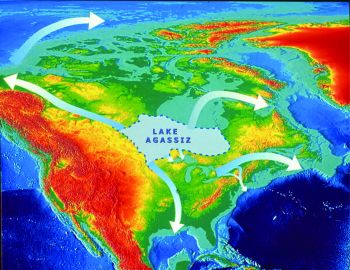Broadcast: News items
Research reveals route that led to ancient Big Freeze
By: Alison Field
Last updated: Wednesday, 7 April 2010

Transit of ice water through the ocean systems of the Northern Hemisphere
University of Sussex Arctic geologist Dr Julian Murton has helped unlock the mystery of a sudden Big Freeze that began on our planet more than 12,000 years ago and which has puzzled fellow academics for decades.
The Younger Dryas cold interval - an abrupt cooling in the Northern Hemisphere temperatures that resulted in much harsher winters for around 1,400 years - began, ironically, at the end of the last Ice Age, about 12,900 years ago.
Scientists have been trying to work out why such a sudden and dramatic cooling event in the Northern Hemisphere would have taken place at that time, and how it happened.
Before now, the most recent thinking was that the climate cooling was caused by vast volumes of icy water bursting out of a giant Ice Age lake in Northwest Canada directly into the North Atlantic Ocean, shutting down the ocean circulation there. But how did the water get into the Atlantic?
Julian, who has been researching Ice Age geology for 20 years and whose findings were published this month in the science journal Nature, has identified the most likely route that the flood waters took, triggering a cooling action that led, in geological terms, to the world's last big "cold snap".
Julian was on a field trip to study permafrost on Richards Island in Canada's arctic coastal plain when he investigated an unusual gravel deposit. Dating tests by a University of Sheffield geologist revealed that the gravel was no older than 13,000 years and could only have been deposited at that elevation and quantity by a massive flood travelling northward into the Arctic Ocean. The discovery led to Julian's solution to the mystery of the Younger Dryas Big Freeze.
Scientists had previously thought but could not prove that the abrupt climate cooling experienced in the Northern Hemisphere was triggered by a catastrophic flood of ice melt water that drained out of Lake Agassiz. The lake, at times bigger than the UK, was one of several massive ice-melt "ponds" that formed along the peripheries of the North American ice sheet as it shrank at the end of the last Ice Age.
According to Julian's observations, based on the gravel find, thousands of cubic kilometres of water burst out of Lake Agassiz and flowed through the Northwest Territories of Canada into the Arctic ocean. These observations support the idea that a huge influx of freshwater enhanced sea ice formation in the Arctic Ocean and, in turn, enhanced the export of sea ice southwards into the North Atlantic Ocean. As the sea ice melted, the fresh meltwater effectively switched off the North Atlantic's circulation system, chilling the climate of the Northern Hemisphere. Winter temperatures in northern Europe plummeted by as much as 22 degrees C.
Julian says: "This discovery demonstrates that many elements of the earth's climate system are strongly linked. Changes in one part can have an impact on others. In this case, the discharge of ice melt water into the Arctic Ocean had a significant effect on Europe's climate."

